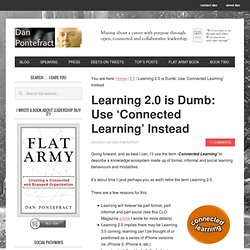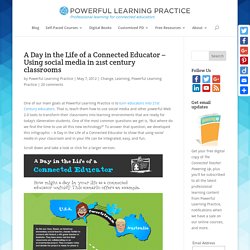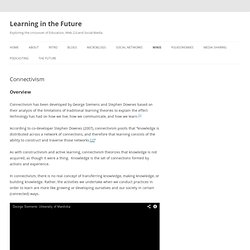

Heaven. Connectivism. Learning 2.0 is Dumb: Use ‘Connected Learning’ Instead. Going forward, and as best I can, I’ll use the term ‘Connected Learning’ to describe a knowledge ecosystem made up of formal, informal and social learning behaviours and modalities.

It’s about time I (and perhaps you as well) retire the term Learning 2.0. There are a few reasons for this: Therefore, I present to you ‘Connected Learning’ … at least from a modality perspective: If ‘Connected Learning’ is part formal, part informal and part social, there will always be the act of ‘connecting’ one’s self to people, content, systems, networks, etc. during the learning process itself … and it may occur through several mediums. From E-Learning to We-Learning. The corporate training industry is undergoing some major changes.

Over last few months we have been involved in many discussions with organizations about the tremendous needs to build, manage, and formalize their social and collaborative learning programs. This is being driven by many factors: the slowing economy, the "always-connected" nature of the workforce, and the explosion of social software tools and platforms now available. In many ways, this transition is very similar to the last "big thing" to hit corporate training - the "e-learning" era.
The word "e-learning" started in 1998 and we went through a radical change in thinking about training over the next 10 years. I think today's transformation is very similar and we have much we can learn from that history. The History of E-Learning and What We Learned E-learning radically changed the training industry. A Day in the Life of a Connected Educator – Using social media in 21st century classrooms. One of our main goals at Powerful Learning Practice is to turn educators into 21st Century educators.

That is, teach them how to use social media and other powerful Web 2.0 tools to transform their classrooms into learning environments that are ready for today’s iGeneration students. One of the most common questions we get is, “But where do we find the time to use all this new technology?” To answer that question, we developed this infographic – A Day in the Life of a Connected Educator to show that using social media in your classroom and in your life can be integrated, easy, and fun. Scroll down and take a look or click for a larger version. Get connected Would you like to become a connected educator? Explore more about the life of a Connected Educator and 21st Century teacher & learner in The Connected Educator: Learning and Leading in a Digital Age by Sheryl Nussbaum-Beach and Lani Ritter Hall. Tweet all about it What does a typical day in a 21st century classroom look like?
Connected Learning Principles. We are living in a historical moment of transformation and realignment in the creation and sharing of knowledge, in social, political and economic life, and in global connectedness.

There is wide agreement that we need new models of education suited to this historic moment, and not simply new models of schooling, but entirely new visions of learning better suited to the increasing complexity, connectivity, and velocity of our new knowledge society. Fortunately, we are also able to harness the same technologies and social processes that have powered these transformations in order to provide the next generation with learning experiences that open doors to academic achievement, economic opportunity, and civic engagement. Learning in the Future. Overview Connectivism has been developed by George Siemens and Stephen Downes based on their analysis of the limitations of traditional learning theories to explain the effect technology has had on how we live, how we communicate, and how we learn.[1] According to co-developer Stephen Downes (2007), connectivism posits that “knowledge is distributed across a network of connections, and therefore that learning consists of the ability to construct and traverse those networks.[2]” As with constructivism and active learning, connectivism theorizes that knowledge is not acquired, as though it were a thing.

Knowledge is the set of connections formed by actions and experience. Connected Learning and Digital Literacy. ~ Connectivism ~ A word which I’d never encountered before three weeks ago.

A theory which is beginning to make sense to me. An area I’m growing my confidence in. This is my current understanding of what it means: Connectivism is the next evolution of the learning “-isms”: behaviourism, cognitivism, constructivism. It is a learning theory for the digital age – one which acknowledges we live in a world of multiplicity.
Teaching-in-the-CL-classroom.pdf.